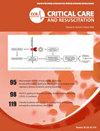A framework and analytical exploration for a data-driven update of the Sequential Organ Failure Assessment (SOFA) score in sepsis
IF 1.7
4区 医学
Q3 CRITICAL CARE MEDICINE
引用次数: 0
Abstract
Objective
The Sepsis-3 consensus statement emphasised the need for data-based approaches to organ failure assessment and use the Sequential Organ Failure Assessment (SOFA) for this purpose. We aimed to develop a framework for a data-driven update to the SOFA score for patients with sepsis.
Design
Systematic analysis of potential markers of organ dysfunction in a retrospective, observational study.
Setting
Intensive care units from three tertiary hospital centres in the United States, the Netherlands, and Austria were included in the study.
Participants
28 100 American, 5339 Dutch, and 2450 Austrian patients with suspected sepsis were included in this study.
Measurements and main results
We assessed 56 organ function variables. We applied area under curve maximisation procedures to optimise the predictive power for mortality. We chose the most predictive biomarker for existing organ dysfunction domains and added a metabolic domain. We compared the area under the receiver operating characteristic curve and the area under the precision recall curve of the data-driven approach against the current SOFA system. The novel approach outperformed the current SOFA in all domains and databases (the area under the receiver operating characteristic curve: for US patients: 0.766 vs. 0.727, mortality: 10.7%; for Dutch patients: 0.70 vs. 0.653, mortality: 22.0%; for Austrian patients: 0.704 vs. 0.665, mortality: 22.0%; all p < 0.01 for the best performing score). The precision-recall curve confirmed such observations.
Conclusions
We developed and validated a framework for a data-driven update to the SOFA to identify and classify organ dysfunction in suspected septic patients. This framework can be used to revise the SOFA score and its application to the identification and classification of sepsis.
脓毒症中顺序器官衰竭评估(SOFA)评分数据驱动更新的框架和分析探索
目的:脓毒症-3共识声明强调需要基于数据的器官衰竭评估方法,并为此目的使用序贯器官衰竭评估(SOFA)。我们的目的是为脓毒症患者的SOFA评分开发一个数据驱动的更新框架。设计回顾性观察性研究系统分析器官功能障碍的潜在标志物。来自美国、荷兰和奥地利三所三级医院中心的重症监护病房被纳入研究。研究纳入了100名美国、5339名荷兰和2450名奥地利疑似脓毒症患者。测量和主要结果我们评估了56个器官功能变量。我们应用曲线下面积最大化程序来优化死亡率的预测能力。我们选择了对现有器官功能障碍域最具预测性的生物标志物,并添加了一个代谢域。我们将数据驱动方法与现有的SOFA系统比较了接收者工作特征曲线下的面积和精确召回曲线下的面积。这种新方法在所有领域和数据库中都优于当前的SOFA(美国患者的受试者工作特征曲线下面积:0.766 vs 0.727,死亡率:10.7%;荷兰患者:0.70 vs 0.653,死亡率:22.0%;奥地利患者:0.704 vs 0.665,死亡率:22.0%;所有p <;最佳表现分数为0.01)。精确率-召回率曲线证实了这些观察结果。结论:我们开发并验证了一个数据驱动的SOFA更新框架,以识别和分类疑似脓毒症患者的器官功能障碍。该框架可用于修订SOFA评分及其在脓毒症识别和分类中的应用。
本文章由计算机程序翻译,如有差异,请以英文原文为准。
求助全文
约1分钟内获得全文
求助全文
来源期刊

Critical Care and Resuscitation
CRITICAL CARE MEDICINE-
CiteScore
7.70
自引率
3.40%
发文量
44
审稿时长
>12 weeks
期刊介绍:
ritical Care and Resuscitation (CC&R) is the official scientific journal of the College of Intensive Care Medicine (CICM). The Journal is a quarterly publication (ISSN 1441-2772) with original articles of scientific and clinical interest in the specialities of Critical Care, Intensive Care, Anaesthesia, Emergency Medicine and related disciplines.
The Journal is received by all Fellows and trainees, along with an increasing number of subscribers from around the world.
The CC&R Journal currently has an impact factor of 3.3, placing it in 8th position in world critical care journals and in first position in the world outside the USA and Europe.
 求助内容:
求助内容: 应助结果提醒方式:
应助结果提醒方式:


